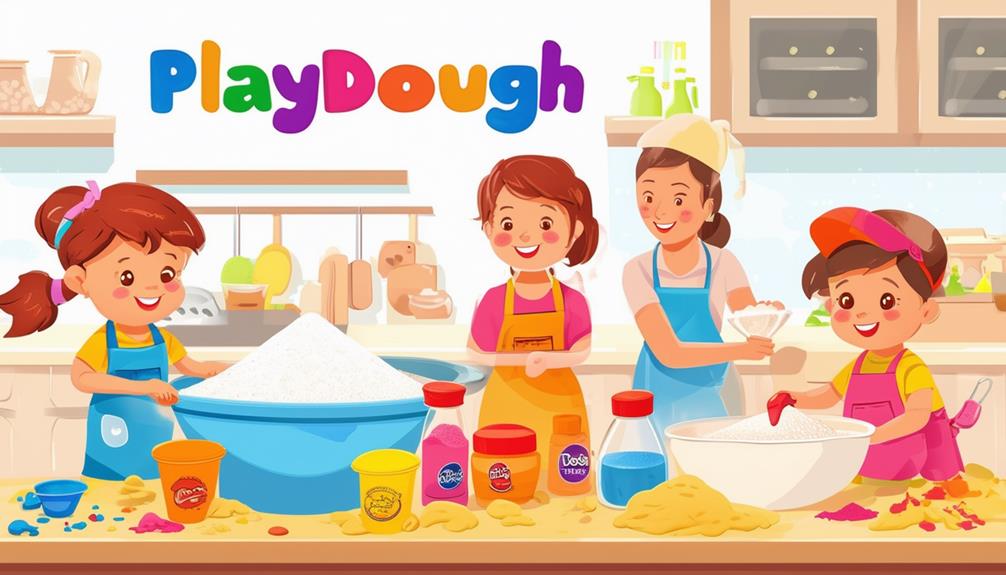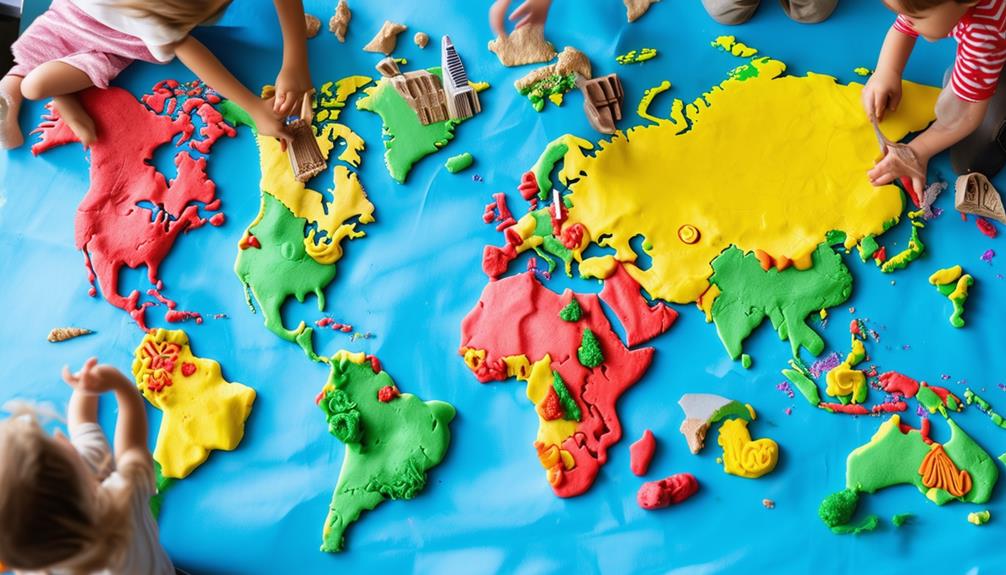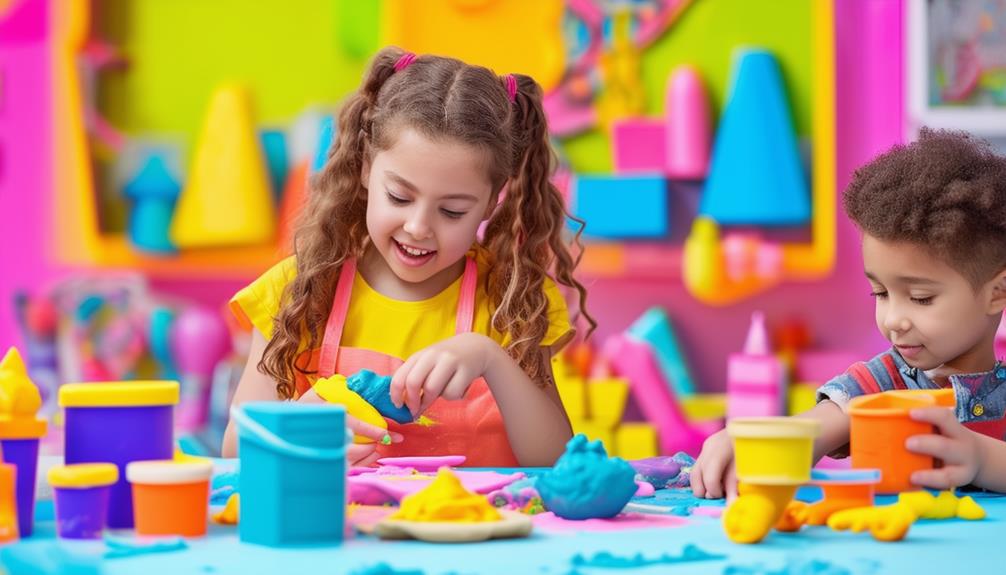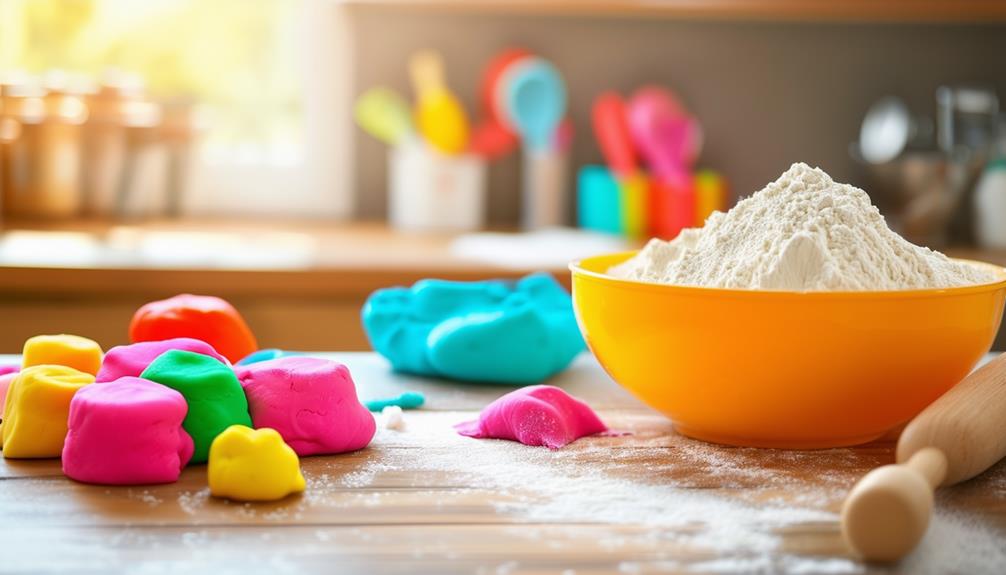The History of Playdough: From Invention to Today

Imagine discovering that a simple wallpaper cleaner could transform into one of the most iconic toys of all time. You'd be intrigued by how Noah McVicker's 1930s invention, initially designed to remove soot from walls, evolved into Play-Doh. Through a series of clever rebrandings and strategic marketing moves, Play-Doh found its way into classrooms and homes worldwide. But what exactly ignited this transformation? And how did it capture the imaginations of millions over the decades? Let's delve into the fascinating evolution of Play-Doh, from its humble beginnings to its celebrated status today.
The Accidental Invention
Noah McVicker's creation of Play-Doh began as an attempt to develop a wallpaper cleaner in the 1930s while working for Kutol Products, a company that primarily produced soap. Tasked with creating a compound to clean soot from wallpaper, McVicker formulated a mixture using ingredients like flour, water, salt, boric acid, and mineral oil. Unbeknownst to him, this mixture would eventually become a household staple, not for cleaning, but for children's play.
Initially, McVicker's invention was not recognized for its potential beyond cleaning. However, the compound's pliability and non-toxic nature made it easy to mold and shape, setting the stage for its future use as a modeling compound.
Noah McVicker's work at Kutol Products laid the foundation for what would become a beloved children's toy. His simple wallpaper cleaner transformed thanks to its unexpected properties and the vision of his nephew, Joseph McVicker. Noah's initial creation sparked the evolution from an accidental invention to a household name.
From Cleaner to Toy
Play-Doh originally began as a wallpaper cleaner in the 1930s. It wasn't long before teachers recognized its potential as an arts and crafts material, leading to its transformation into a popular classroom tool. This innovative repurposing helped Play-Doh become a beloved children's toy, firmly establishing its presence in both schools and homes.
Accidental Creation Origins
In the 1930s, a surprising discovery turned a wallpaper cleaning compound into what we now know as Play-Doh. While working for Kutol Products, Noah McVicker developed a cleaner designed to remove soot from wallpaper. The original formula, consisting of wheat flour, water, salt, boric acid, and mineral oil, was intended as a non-toxic solution for households dealing with coal heating residue.
Here's a summary of the key components and their functions:
| Ingredient | Purpose | Outcome |
|---|---|---|
| Wheat Flour | Binding agent | Provided structure |
| Water | Solvent | Created malleability |
| Salt | Preservative | Extended shelf life |
| Boric Acid | Antifungal | Prevented mold growth |
| Mineral Oil | Lubricant | Maintained smooth texture |
The cleaner worked effectively, but it wasn't until later that its true potential was realized. The compound's unique texture made it enjoyable to manipulate by hand. Noah's nephew, Joseph McVicker, later identified its potential as a children's toy, leading to the birth of Play-Doh. This accidental creation by Noah McVicker laid the foundation for a beloved plaything enjoyed by generations.
Repurposing for Kids
Recognizing the compound's playful potential, Joseph McVicker repurposed the wallpaper cleaner into what we now know as Play-Doh in the mid-1950s. This transformation marked the beginning of an iconic modeling compound for children. McVicker saw an opportunity to take a mundane cleaning product and turn it into something magical for kids. Play-Doh quickly became a hit, providing endless hours of entertainment and creativity.
The appeal of Play-Doh extended beyond children. Teachers soon discovered its potential for arts and crafts activities in classrooms. They used it to help children develop fine motor skills, stimulate creativity, and teach basic concepts like shapes and colors. Its versatile nature made Play-Doh an ideal educational tool.
Four key factors contributed to Play-Doh's success as a children's toy:
- Engaging Texture: The soft, pliable compound is easy for small hands to mold.
- Safety: Non-toxic and safe for children to use.
- Versatility: Suitable for a wide range of arts and crafts projects.
- Educational Value: Useful for teaching diverse subjects creatively.
Transition to Schools
After teachers discovered Play-Doh's modeling potential, it swiftly transitioned from a wallpaper cleaner to a school supply cherished for creative projects. This change began when educators noticed children molding and shaping the compound during arts and crafts sessions. Its versatility and non-toxic properties made it an instant favorite for classroom activities.
In 1956, Play-Doh's shift from cleaner to classroom essential accelerated when it was showcased at an educational convention. Teachers at the event recognized its potential to enhance learning through hands-on creativity. They started incorporating it into lesson plans, and its educational benefits quickly spread. Play-Doh soon became a preferred tool for fostering imagination and fine motor skills in young learners.
Schools across the country embraced Play-Doh for its ability to engage students in interactive learning. Teachers found it perfect for various subjects, from forming geometric shapes in math class to sculpting historical figures in social studies. Its safe, moldable texture made it suitable for children of all ages. As a result, Play-Doh established itself as a key component of school arts and crafts programs, nurturing creativity and enjoyment in educational settings.
Composition and Safety

Play-Doh is composed of basic, non-toxic ingredients such as wheat flour, water, salt, boric acid, and mineral oil, making it safe for children. Its simple and harmless formulation is why many parents prefer it, allowing kids to explore their creativity without the risk of exposure to harmful substances.
Here are the key reasons why Play-Doh stands out in terms of safety and composition:
- Non-Toxic Ingredients: The child-friendly ingredients eliminate concerns about negative health impacts.
- Easy Cleanup: Its non-staining properties ensure that any mess can be cleaned up effortlessly.
- Widespread Use: Schools and households both rely on Play-Doh for arts and crafts, thanks to its safe composition.
- Creative Flexibility: The pliable formula allows children to create various shapes and forms, fostering imaginative play.
Originally designed for cleaning wallpaper, Play-Doh's ingredients were repurposed to develop a safe modeling material for children. Its secure composition has led to its widespread adoption, making it a staple in educational and domestic settings.
Early Marketing Strategies
Early marketing strategies for Play-Doh capitalized on its safe, child-friendly composition by focusing on educational conventions and demonstrations in the mid-1950s. The compound's non-toxic nature made it highly appealing to both parents and educators. In 1956, the Rainbow Crafts Company was established and specifically marketed Play-Doh to schools, highlighting its educational benefits.
These strategies emphasized Play-Doh's potential as a learning tool, not just a toy. Teachers could use it to enhance creativity and fine motor skills in young children. By attending educational conventions and conducting live demonstrations, the company engaged directly with educators to showcase the compound's versatility.
Rainbow Crafts also targeted department stores to expand Play-Doh's reach, recognizing its appeal beyond the classroom and into households. The introduction of new colors and accessories, such as the Fun Factory in 1960, further diversified its market presence. These innovations kept the product exciting and relevant, ensuring its place in children's playrooms. Through these strategic moves, Play-Doh solidified its position in the toy market, laying the foundation for future marketing efforts.
The Role of TV Ads

Play-Doh's rise to fame can be attributed to the power of TV ads on children's shows like Captain Kangaroo in 1957. These commercials didn't just demonstrate how fun and creative Play-Doh could be; they also transformed it into a household name. This exposure led to Play-Doh quickly becoming a must-have toy, signifying a major breakthrough in marketing and sales.
Children's Television Program Influence
In 1957, TV ads on popular children's programs like Captain Kangaroo brought Play-Doh into the national spotlight. This strategic move into television advertising was crucial for Play-Doh's rise to fame. Children's television programs were the ideal platform to showcase the toy's potential, with vibrant commercials that highlighted Play-Doh's colorful appeal and endless sculpting capabilities.
TV ads on shows like Captain Kangaroo made both kids and parents take notice. These ads influenced Play-Doh's popularity in several ways:
- Increased Visibility: Airing during popular children's TV programs, Play-Doh reached a wide audience, becoming a household name.
- Demonstrated Versatility: Commercials showed kids creating various shapes and figures, sparking imagination and creativity.
- Engaged Young Audiences: The bright colors and fun designs in the ads captivated children, making them eager to join the fun.
- Parental Appeal: Parents viewed Play-Doh as a safe and educational toy, thanks to its positive portrayal in TV commercials.
These television advertising efforts were essential in establishing Play-Doh as a beloved toy, enhancing its popularity among children nationwide.
Marketing Breakthrough and Success
Television ads in the late 1950s propelled Play-Doh into the limelight, driving its rapid ascent in the toy industry. When Play-Doh first appeared on popular children's shows like *Captain Kangaroo* in 1957, it captivated kids nationwide. These TV ads weren't just about showcasing a product; they highlighted the creative potential of Play-Doh, encouraging children to sculpt, shape, and discover.
The impactful marketing strategy behind these ads played a pivotal role in introducing Play-Doh to a broader audience. By leveraging the influence of beloved TV programs, Play-Doh quickly became a household name. The engaging commercials didn't just inform; they inspired. Kids were eager to replicate the fun and creativity they saw on screen, and parents were keen to buy a toy that promised hours of imaginative play.
This clever use of TV advertising not only boosted Play-Doh's sales but also cemented its place in the toy industry. The widespread recognition and popularity gained from these ads led to sustained growth and success. Thanks to this strategic marketing approach, Play-Doh evolved from a simple modeling compound to a timeless staple in children's playrooms.
Iconic Accessories
The Fun Factory, introduced in 1960, revolutionized Play-Doh play by allowing children to extrude the dough into a variety of creative shapes. This innovation marked the beginning of Play-Doh's journey toward a diverse range of imaginative accessories that have sparked endless creativity. Picture the thrill of pushing Play-Doh through the extruder and seeing it emerge as stars, squares, or spaghetti strands. This was merely the inception of Play-Doh's accessory evolution.
Over the years, numerous accessories have been added, each contributing a new dimension to Play-Doh activities. Here are four iconic items that every Play-Doh enthusiast will recognize:
- The Mop Top Hair Shop: This set enables kids to grow and style colorful Play-Doh hair on character models.
- The Doctor Drill 'n Fill Playset: Children can play dentist by creating teeth and then drilling cavities.
- The Burger Barbecue Set: Craft realistic-looking burgers, hot dogs, and all the trimmings.
- The Sweet Shoppe Playset: Design intricate and convincing Play-Doh desserts.
These accessories have broadened imaginative possibilities, allowing children to explore various roles and scenarios. Play-Doh's lasting appeal is rooted in these creative tools, which have delighted generations and continue to foster artistic expression.
Global Expansion

Play-Doh's journey beyond American borders began in 1964 with its introduction to Europe. This milestone marked the start of a global expedition that saw the beloved modeling compound reach households worldwide. By 2005, Play-Doh was available in over 75 countries, reflecting its widespread appeal. Children everywhere could enjoy creating colorful masterpieces with the iconic colors red, yellow, and blue.
Play-Doh's international expansion was significantly bolstered by its presence on children's television shows. These shows highlighted the product's versatility and creativity, captivating young audiences and encouraging imaginative play. The brand's global success led to the development of various merchandise and accessories designed to enhance the Play-Doh experience.
Here's a snapshot of Play-Doh's global journey:
| Year | Milestone | Impact |
|---|---|---|
| 1964 | Introduction to Europe | Play-Doh's first step toward global recognition |
| 1984 | First appearance on TV shows | Increased popularity among children |
| 1990 | Expansion into Asia | Further solidified its status as a beloved toy |
| 2000 | Introduction of new colors | Enriched creativity with more color options |
| 2005 | Available in 75 countries | Cemented its place as a global household name |
The widespread distribution and continuous innovation ensured that Play-Doh remained a favorite toy for kids around the world, transcending cultural and geographical barriers.
Industry Recognition
Play-Doh's industry recognition underscores its enduring impact and popularity in the world of toys. Since its inception, Play-Doh has captivated the imaginations of children and earned significant accolades within the toy industry. A notable honor came in 1998 when Play-Doh was inducted into The Strong's National Toy Hall of Fame, cementing its status as a timeless classic appreciated by generations.
Play-Doh's success extends beyond awards, as evidenced by its impressive sales figures. Over 2 billion cans of Play-Doh have been sold worldwide, reflecting its widespread appeal and enduring relevance.
Key milestones in Play-Doh's evolution include:
- 1960: Introduction of Play-Doh accessories and playsets, expanding creative possibilities for children.
- 1998: Induction into The Strong's National Toy Hall of Fame.
- General Mills: Crucial in the early years for marketing and distribution growth.
- Sales Milestone: Over 2 billion cans sold globally, highlighting its extensive reach and success.
Play-Doh's legacy continues to thrive, celebrated in both homes and historical collections.
Modern-Day Play-Doh

Owned by Hasbro, Play-Doh continues to inspire young minds with its extensive array of colors and creative playsets. As part of the Playskool line, Play-Doh has sold over 700 million pounds globally. Its lasting popularity is evident—children and parents alike value the endless possibilities for creative projects that Play-Doh offers.
The product line includes a broad spectrum of colors, from traditional primary shades to glittery varieties, ensuring that every artistic vision can come to life. Whether you're sculpting a miniature zoo or crafting a pretend feast, there's a Play-Doh set designed to spark your imagination. A diverse range of themed playsets, from kitchen creations to animal adventures, allows children to engage in creative storytelling and hands-on learning.
Accessibility is key to Play-Doh's modern success. Play-Doh products are readily available in retail stores and online, making them a convenient choice for busy parents. It's no wonder that Play-Doh remains a beloved modeling compound for kids, offering not just fun but also developmental benefits like improved fine motor skills and enhanced creativity. In today's fast-paced world, Play-Doh continues to be a top choice for children's arts and crafts.




